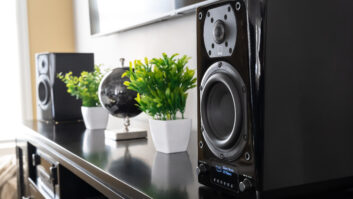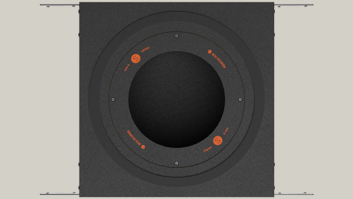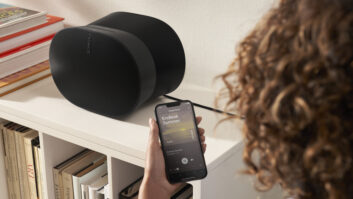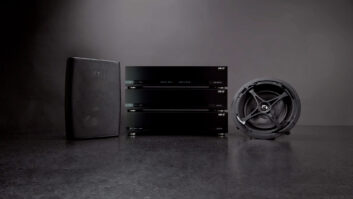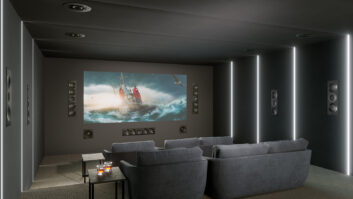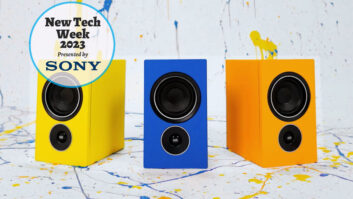The words “high-end” and “in-wall speaker” very rarely cross paths. Most times, when we specify in-walls it is for those secondary listening areas or if a customer is looking for a modern, “invisible” look to flank a flat panel display. But when someone starts talking about wanting serious audio quality for a theater or dedicated listening room, we typically try to steer them to a freestanding model that can deliver greater dynamics and impact.

Last year I took a listen to Monitor Audio’s new Controlled Performance (CP) Series architectural speakers (review available online at residentialsystems.com) which are designed to address the biggest issue with traditional inwall/ in-ceiling designs: the in-wall part. At the time, the lineup featured 10 speakers across four performance levels, all featuring integrated, fully sealed back boxes and drivers optimized to deliver reliable and consistent audio regardless of the wall/ ceiling cavity.
This year, Monitor extended the CP lineup’s reach by introducing two new models, the CPIW260X and CP-IW460X, creating a new category the company calls “Full-Sized Luxury” in-wall speakers. And arriving in boxes standing 40 inches high, it is abundantly clear Monitor isn’t playing around with the term “full-sized.”
Both models feature impressive build quality, weighing more than 26 pounds per speaker with five drivers arranged in a bass-mid-tweet-mid-bass configuration. Each speaker offers adjustments for fine-tuning the audio in a room, with high- and mid-level frequency adjustment (+1/0/-1 dB settings) as well as a boundary compensation switch to help tame boomy bass if the speaker is positioned too near a corner.
While both speakers include dual 6.5-inch bass drivers and dual 4-inch mid drivers, the primary differences between the 260X and 460X are in driver composition. The 260X utilizes Monitor’s Ceramic-Coated Aluminum/Magnesium (C-CAM) drivers and a 1-inch C-CAM Gold Dome tweeter that is rated up to 30kHz. Due to the even dispersion pattern of the dome tweeter, the speaker can be used horizontally as a center channel with no sonic issues. I would have liked to see some tweeter adjustment to “toe” the sound toward the listening position, but in my 14-foot wide room, I never felt any lack of focus or imaging.
The 460X ups the performance ante by utilizing Monitor’s Rigid Surface Technology (RST) on all the bass and mid drivers. Monitor claims RST is inspired by the Japanese art of Origami: using sophisticated computer modeling, a precise pattern of dimples is applied, strengthening the driver material and increasing surface rigidity. According the Monitor, “The strengthening effect of RST means that we can use thinner, lighter, and more responsive C-CAM cones, which provide speed and accuracy while offering greatly reduced distortion.”
But the biggest difference between the two models–and the one that delivers the most significant performance differentiator–is the 460X’s High Frequency Ribbon Tweeter, which has been ported down from Monitor’s vaunted Gold Series and used here for the first time in an in-wall design. The tweeter resides in an innovative rotating housing, letting you pivot it 90 degrees if positioning the speaker horizontally, and performance is rated up to 60kHz, which I’ll just have to take Monitor’s word for.

While both Monitor Audio speakers include dual 6.5-inch bass drivers and dual 4-inch mid drivers, the primary differences between the 260X and 460X are in driver composition. Textured cones (on previous page) on the 460s are a visual difference.
Getting these massive cabinets inside a wall requires cutting out a significant 34 21/32 x 9-inch hole. Obviously making sure there is no blocking, wiring, or other impediments is crucial. Probably my biggest nit with these speakers is the included cutout templates, which offer no easy way to trace the speaker cutout dimensions on a wall. I guess I could have used scissors to cut out the template, but ultimately just used a tape measure and level before chopping away.
The speakers feature 10 Tri-Grip “dog fixings” to insure they stay snug and secure into the wall. The heavy-duty gold binding posts are smartly positioned on the side of the cabinet; firmly holding large-gauge wire or banana plugs while keeping wiring routed away from the back of the speaker where it could keep it from sitting flush. The grille has powerful magnets that hold it snugly in place and is of the sleek, bezel-less design. The grille does not sit completely flush with the wall, rather sticking out by about 1/8 of an inch.
I’d be lying if I said I listened to the 260Xs first, but I’ll start with their performance. The opening vocals of Sia’s “Straight for the Knife” from her album 1000 Forms of Fear has wonderful space and depth, and the 260Xs delivered the subtle reverb in the recording, her voice breathing into the room and then lingering before decaying and disappearing. The speakers are also capable of producing massive envelopment and spaciousness. “Video Games” by Lana Del Rey has a soundstage so immense and wide that it sounded as if I had surround speakers positioned around me.
As good as the 260Xs sounded, however, the 460Xs were just next level. Turning on the 460Xs was like removing the proverbial veil from the sound, releasing this sense of space and delicacy around every recording, and letting every note stand clear and ready to be appreciated. The audio is airy, open, detailed, lightning-quick, and effortless. These are speakers that sit there begging you to explore your music library, pulling out old favorites, and really listening to music. The ribbon tweeter is so fast and revealing, it excels at extracting the fine details from any delicate parts of a recording; taking loving, kid gloves to stringed instruments, female vocals, piano notes, cymbal work, and the like, carefully polishing them up, and delivering them in glorious, refined detail.
Sinead O’Connor’s Am I Not Your Girl? is an album filled with smoky, jazz club standards and her “Don’t Cry for me Argentina” is my favorite version of the song. The 460Xs captured the aching detail in her voice, even the nearly indistinct sound of her lips parting as she opens her mouth to sing.
If you have been skeptical of high-resolution audio, not thinking you could hear or appreciate the detail, the 460Xs will take you to church and make you a believer. I’ve listened to Kind of Blue so many times that I’ve lost track, but I couldn’t resist hearing it yet again through the 460Xs, and they absolutely delivered, presenting a soundstage that brought Miles and company into my listening room, each instrument perfectly positioned across the front wall. Perhaps most noticeable was the fine detail of drummer Jimmy Cobb, whose delicate cymbal work is laid back but ever-present and distinct through the album.
Both models are listed as being highly efficient and producing maximum SPL “for powerful home theatre installations,” with the speakers rated to deliver up to 113.8dB. I happened to be in my listening room the night George Michael died, and I explored several of his tracks at levels pushing 95dB. The imaging remained just bulls-eye spot on, locking the lead vocals to the center of the room, floating clearly a few feet ahead of the wall, loud, clear, and easily understandable.
While both speakers were capable of producing sometimes surprisingly deep bass, especially considering they are only rated down to 50Hz, bassheavy pop is not their forté. One of my favorite bass tests is the deep note from The Crystal Method’s “High Roller,” and while the notes were there, neither speaker could drive it through your chest the way larger speakers can. I had the OEM in-wall subwoofer system on hand from a previous review and engaging them truly energized the entire room, revealing that lowest octave that the speakers just weren’t able to plumb. Adding a sub turned the 260Xs into a truly full-range musical experience, and transformed the 460Xs into audiophile- Nirvana territory.
In-wall speakers can have a preconceived performance ceiling on them, with customers thinking they are a compromised experience. These speakers from Monitor Audio go a long way to dispel that myth, and I’d go so far as to say if you were to A/B the 460Xs against other speakers, I imagine people would forget how much they cost– and that they are in-walls at all–and just be unable to settle for anything less.

